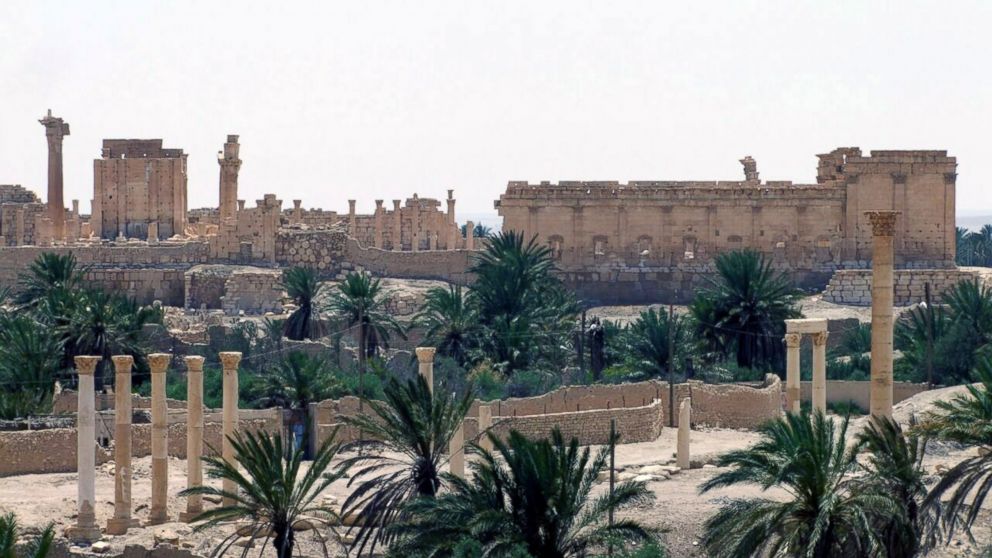


Just five days after ISIS achieved one of its most significant victories in Iraq in the past year, militants reportedly have taken control of the ancient city of Palmyra in Syria.
The city’s ruins hold some of the world’s most prized antiquities dating back to the 1st and 2nd centuries, and ISIS’ past assaults on historic sites have caused alarm among the international community that the group might employ the same tactics once again.
“Any destruction to Palmyra is not just a world crime, it will mean an enormous loss for humanity,” said UNESCO Director-General Irina Bokova in a video posted by the group Thursday. “We are speaking about the birth of human civilization.”
Fall of Ramadi: 30 Car Bombs, 10 as Big as Oklahoma City Blast, US Official Says Officials: ISIS Figure’s Wife Cooperating With US InterrogatorsPalmyra is home to some of the world’s best-preserved ancient ruins, including the Temple of Bel, built in the first century.
Over the past 2,000 years, Palmyra has been consistently reshaped by the influences of ancient Romans, and served as a trade hub for caravans along the Silk Road from India, China and Persia. It led to an amassing of treasures from a diverse array of civilizations.
“What Palmyra tells us today is that all cultures are influencing each other, all cultures enrich each other,” Bokova said.
However, over the past two years following the start of the Syrian Civil War, Palmyra saw military facilities propped up by forces loyal to Syria’s President Bashar al Assad. Reports of looting and significant damage to some of the city’s ancient architecture followed.
Its new inhabitants, however, believe preserving ancient ruins constitutes a form of idolatry and have made several propaganda videos flaunting their record in some of Syria and Iraq’s most historic destinations.
One of the first notable examples of ISIS’ targeting of historical sites was the video posted online of the destruction of the Nebi Yunus, or the Tomb of the Prophet Jonah, inside Mosul, Iraq.
Just one week ago, in a U.S. House Foreign Affairs Committee hearing on “Ancient Communities Under Attack,” Penn Cultural Heritage Center fellow Katharyn Hanson remarked that ISIS “removed all evidence of the shrine by clearing the rubble and grading the site flat.”
“In doing so,” Hanson said. “ISIS erased the physical presence of Nebi Yunus for the entire local religious community.”
In January 2015, reports surfaced that ISIS militants detonated bombs along the wall of the ancient Iraqi city of Nineveh located on the Tigris River. The city is known for being the oldest in the Assyrian Empire and most notable archaeological monuments in the country.
The next month, ISIS militants armed themselves with sledgehammers, pickaxes and rifles as they raided the Mosul Museum. Cameramen were at the ready as the group tore apart artifacts, including some reported replicas inside, later posting a montage of the rampage online.
Just a month later, ISIS ramped up its campaign of destruction as it reportedly bulldozed the ancient cities of Nimrud and Hatra, also a UNESCO World Heritage site.
UN Official: ISIS Destruction of Ancient City of Nimrud, Artifacts a ‘War Crime’At the time, Bokova called the destruction of Hatra "a turning point in the appalling strategy of cultural cleansing underway in Iraq."
“With this latest act of barbarism against Hatra, Daesh shows the contempt in which it holds the history and heritage of Arab people, which had been rightly recognized as a World Heritage site," Bokova said.
In the House hearing, Hanson also remarked on the apparent looting by ISIS of the Dura-Europos, an archaeological site in Syria that holds not only the world’s best preserved ancient Jewish synagogue but one of the oldest known depictions of Jesus Christ.
“I think we need a total mobilization of the international community,” Bokova said on Palmyra. “We need everybody to launch the same appeal. We need very much the religious leaders to launch an appeal on the prevention of this destruction.”
State Department deputy spokesperson Marie Harf said Thursday that the administration has "spoken out strongly" against the destruction or possible destruction of historic sites including Palmyra.
"I mean, when you talk about who could stop ISIL from destroying them, I think that's a pretty challenging thing to do," Harf said. "We've certainly called on them not to. This is a tough fight here, though."
Sister Diana Momeka of the Dominican Sisters of Saint Catherine of Siena has witnessed the destruction first hand, and testified to the House Foreign Affairs committee just what effect the destruction of the religious and historical sites have on the community.
“What do we lose? I would say we lost everything,” Momeka said. “It just was a sign for us, and that's your history is gone. You are nothing anymore. That's how we see ourselves now. Homeless.”